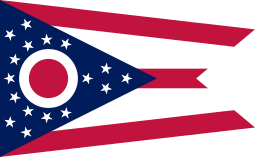Brent Spence Bridge
| Brent Spence Bridge | |
|---|---|
 The Brent Spence Bridge is the furthest bridge to the right as viewed from Downtown Cincinnati | |
| Coordinates | 39°05′27″N 84°31′22″W / 39.09087°N 84.52291°W |
| Carries |
8 lanes (4 upper, 4 lower) of |
| Crosses | Ohio River |
| Locale | Covington, Kentucky and Cincinnati, Ohio |
| Characteristics | |
| Design | Cantilever bridge |
| Total length | 1,736 feet (529 m)[1] |
| Longest span | 830.5 feet (253.1 m) |
| History | |
| Construction cost | $10 million[2] |
| Opened | November 25, 1963 |
The Brent Spence Bridge is a double decker, cantilevered truss bridge that carries Interstates 71 and 75 across the Ohio River between Covington, Kentucky and Cincinnati, Ohio. The top deck carries Kentucky-bound traffic while the bottom deck carries Ohio-bound traffic.

History
The bridge was named for Kentucky's longest serving congressman at the time, Brent Spence, who served in the U.S. Congress for over thirty years before retiring in 1962. The bridge, which opened a year after his retirement, was named in his honor by then Kentucky governor Bert T. Combs. Spence did not feel that he deserved the honor, and lobbied for the Bridge to be named for President Kennedy (who had been assassinated only three days before the bridge was supposed to open). Combs, however, resisted this effort as modesty by Spence and kept the name, though Combs would name the John F. Kennedy Memorial Bridge in Louisville, Kentucky (which opened two weeks after the Spence) after the late president just days after Kennedy's assassination.
Replacement
When the bridge opened in November 1963, it carried only three lanes of traffic each way across the Ohio River. In 1985, the emergency shoulders were eliminated, and the bridge was re-striped with four lanes in each direction, increasing the traffic capacity by 33%, earning the bridge the determination of being 'functionally obsolete' due to carrying more traffic for which it was originally designed.[3] The bridge was designed to carry 85,000 vehicles per day, but in 2006 it carried 150,000 vehicles per day.[4] Recent reports show that contrary to previous traffic expectations, traffic on the Brent Spence Bridge has actually decreased by 9 percent between 2009 and 2015.[5]
On September 15, 2011, chunks of concrete from the Ohio side ramp connected to the bridge fell on to a vehicle.[6] This incident lead to the belief that the Brent Spence Bridge was in immediate need of replacement and in danger of collapse, although this has been rebuked by the Kentucky Transportation Cabinet, and has continued to be declared safe.[7]
As of 2008, the Cincinnati City Council supported alternative #4, which involves building a new bridge to carry I-75 at the current location, and demolishing the Brent Spence Bridge.[8] Alternative #4 would build a parallel bridge just west of the Brent Spence Bridge.[9] It would again be a two deck bridge, except the top deck would carry all I-75 traffic and the bottom deck would carry south I-71 and local traffic.[9] The I-75 deck would be a total of 6 lanes, with 3 lanes each for north and south traffic.[9] The I-71 deck would be a total of 5 lanes, divided into 3 lanes for south local traffic, and 2 lanes of south 71 traffic.[9] Additionally, Cincinnati City Council has expressed interest in using the bridge for a light rail system that would connect downtown Cincinnati to the Cincinnati/Northern Kentucky International Airport.[8]
The Selected Alternative, as described in the Finding of No Significant Impact[10] is Alternative I, which would build a new double deck bridge just west of the existing Brent Spence Bridge to carry three lanes each way for I-75, two lanes for southbound I-71, and three lanes for southbound local traffic. The existing Brent Spence Bridge would be rehabilitated to carry two lanes for northbound I-71 and three lanes for northbound local traffic.[11]
In popular culture
The approach from the Brent Spence Bridge, with the picture of the downtown Cincinnati skyline representing the fictional city of Monticello, was featured on the daytime soap The Edge of Night (a program sponsored by the locally based Procter & Gamble) from 1967 to 1980.
See also
-
 Bridges portal
Bridges portal -
 Kentucky portal
Kentucky portal -
 Ohio portal
Ohio portal -
Cincinnati portal
- List of crossings of the Ohio River
- Cut-in-the-Hill
References
- ↑ "About". Brent Spence Bridge.
- ↑ Tortora, Andrea (May 3, 2007). "Bridge forces push forward, pull together". Cincinnati Business Courier.
- ↑ http://nationalbridges.com/guide-to-ratings
- ↑ "Existing and Future Conditions" (PDF). Brent Spence Bridge Replacement/Rehabilitation Project. February 2006.
- ↑ http://www.bizjournals.com/cincinnati/blog/2016/03/despite-decreasing-brent-spence-traffic-planners.html
- ↑ Hutson, Lisa (September 15, 2014). "Concrete beam falls on car near Paul Brown Stadium, ODOT investigates". WXIX.
- ↑ "Despite decreasing Brent Spence traffic, planners say new bridge is necessary". March 2016.
- 1 2 LeMaster, Kevin (March 28, 2008). "Cincinnati council resolves to save Queensgate businesses, light rail options". Building Cincinnati.
- 1 2 3 4 "Brent Spence Bridge Conceptual Alternatives Study" (PDF). Brent Spence Bridge Replacement/Rehabilitation Project. April 2009.
- ↑ Leffler, Laura (August 9, 2012). "Finding of No Significant Impact" (PDF). Federal Highway Administration.
- ↑ "Environmental Assessment" (PDF). Brent Spence Bridge Replacement/Rehabilitation Project. March 2012. p. 14.
External links
- Cincinnati Enquirer Special about the Brent Spence Bridge
- Brent Spence Bridge at Structurae
- Brent Spence Bridge at Bridges & Tunnels
- Brent Spence Bridge at Cincinnati-Transit.net
- Brent Spence Bridge Corridor study (for bridge replacement/redevelopment)
- Brent Spence Bridge
- Bold design sought for Brent Spence Bridge replacement
